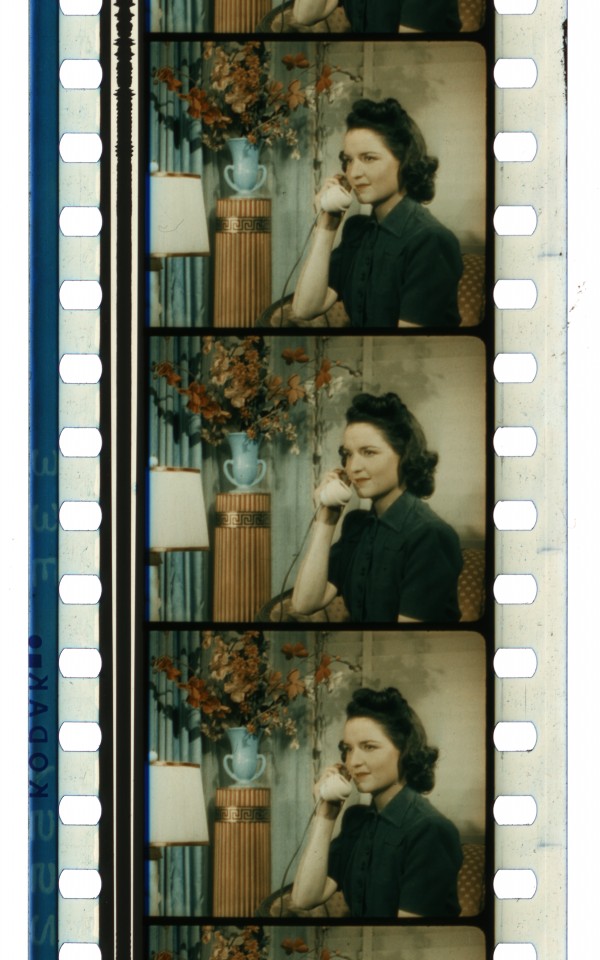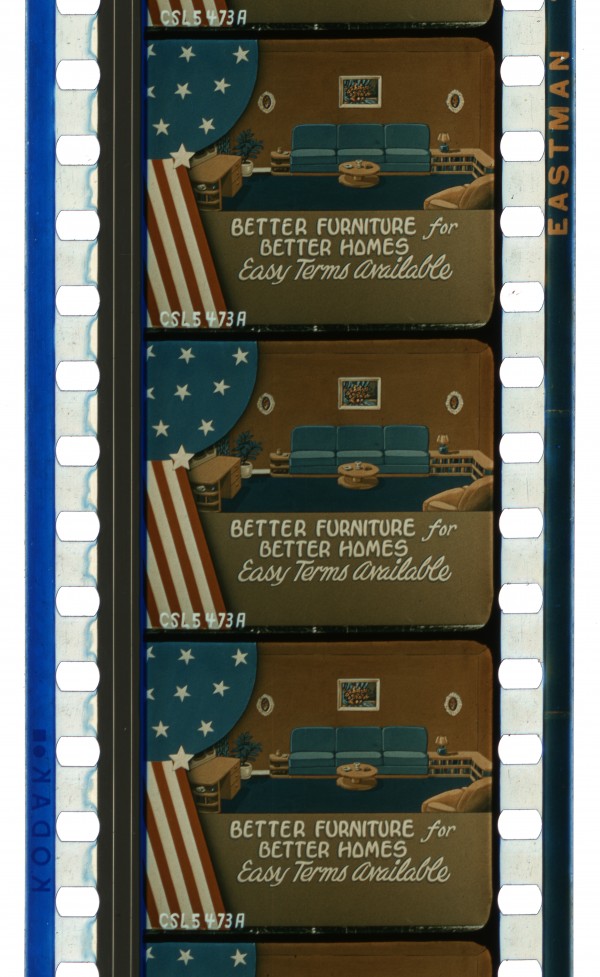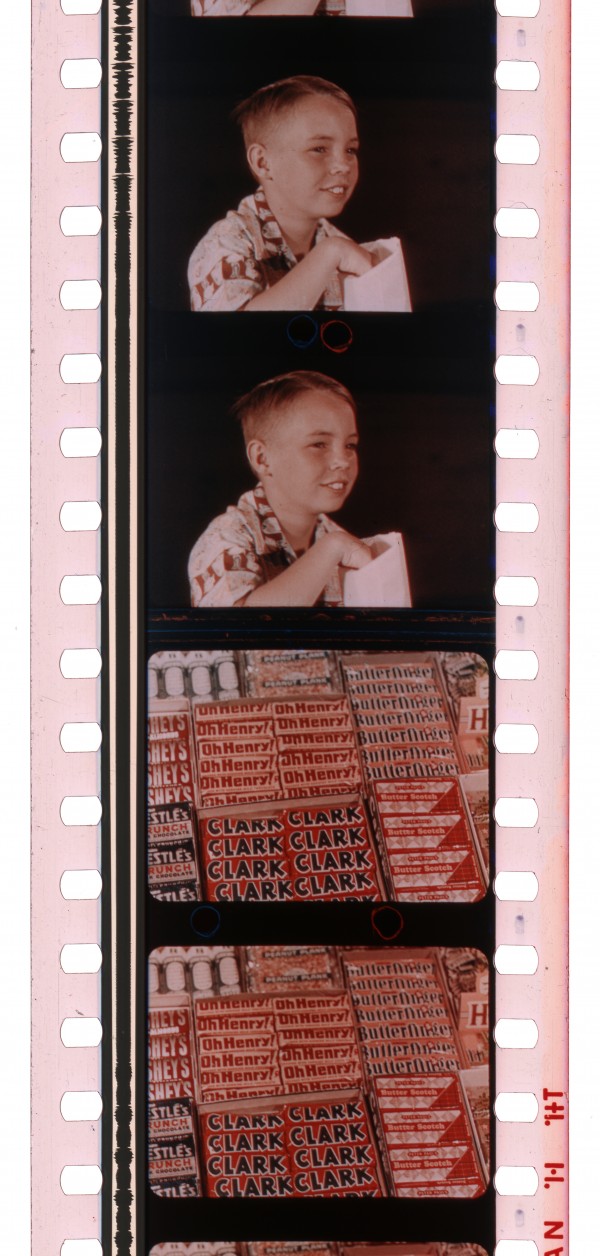A two-color subtractive film process used primarily for industrial films and commercials.
Film Explorer

An example of a commercial printed in Alexander Color, c. 1945. Note the protected silver soundtrack, which would be normally toned blue-green in other processes, and the commercial code number in the frameline, which was applied on the blue-green negative.
Jack Theakston, New York, NY, United States.

Many Alexander Color prints were made for local advertising, like this 1942 commercial for Fain’s furniture store in Flint, Michigan.
Jack Theakston, New York, NY, United States.

A later example of an Alexander Color print on safety stock from the 1950s.
Jack Theakston, New York, NY, United States.
Identification
1.37:1 up to 1.85:1. Alexander's cameras appear to have mostly shot full-aperture frames, but the images would have been projected cropped at 1.37:1 or wider.
Alexander Color prints were duplitized. They were coated with emulsion on both sides of the film base. One side was dye-toned blue – the other red-orange.
Standard Eastman Kodak edge print text is evident. This text typically appears blue, on either a black or blue background.
1
Alexander Color was a two-color process utilizing blue and red-orange component colors. It had a subdued color palette that was incapable of accurately recreating greens and pure red.
All commercials and snipes printed in Alexander Color do not include a direct credit to the color process, but should have a credit for “Alexander Film Co.”. A stock order code in the frame line area outside of the projection area is almost unanimously present.
All Alexander Color prints used RCA variable-area optical sound. The soundtrack area was protected during processing and appears B/W rather than dye-toned like Cinecolor prints.
Two B/W camera negatives were photographed in bipack (sandwiched together in the film gate). One negative captured a blue record – the other a red-orange record.
History
The Alexander Film Company was an industrial film studio located in Colorado Springs, Colorado. The founders of the company, brothers Don M. and J. Don Alexander, established their business in 1919 in Spokane, Washington. The company specialized in producing and distributing custom, on-screen advertising trailers, sold by regional salespeople to theaters, that would then solicit the advertisements from local vendors. So popular was their trailer service that the company expanded across the country and the brothers created a parent company, Alexander Industries, which began manufacturing airplanes for their salesforce. The aircraft were so well-designed that the company opened a plant in Englewood, Colorado in 1925, and, by 1928, they were briefly the largest airplane manufacturer in the world. That ended when a tragic fire at their factory forced the brothers to move operations to Colorado Springs, where they focused on the film-studio side of the business, specializing in advertisements. In the early 1920s, the Alexanders experimented with inventor C. Harry Fischer to perfect a two-color system that could be used for their advertisements. Examples of this are shown as “Natural Color by Alexander Film Co.”.
By 1940, the Alexander Film Co. had dominated its market for theatrical commercial ads, boasting 75 per cent of the screens in the US, across nearly 10,000 theaters. Presumably building upon the work done with Fischer, inventor Don M. tinkered with the idea of using bipack photography and duplitized film stock for release printing, not unlike its chief competitor Cinecolor. The company marketed the process as simply “natural color” in its descriptions. Unlike Cinecolor, however, the soundtrack area on the cyan record of the print was protected from both toner chemicals during printing, leaving a denser, silver soundtrack.
By the early 1950s, the Alexander Film Co. had moved away from its two-color process and began printing advertisements on Eastmancolor stock. The latest-dated two-color examples that have been recorded are from 1955. Alexander Color advertisements are often easy to identify on any stock, as they carry an internal stock code at the end of each trailer on the bottom of the frame, often in the frameline area, or in other unprojected areas of the frame. Two-color examples often carry the Alexander Film Company logo, as well as the trademark for the RCA sound system, which the laboratory used.
Selected Filmography
Technology
Alexander Color used bipack cameras for photography. Two B/W camera negatives were photographed sandwiched together emulsion-to-emulsion, in the film gate. The front negative towards the lens was orthochromatic, and captured a blue-green color record. The emulsion on the orthochromatic negative also carried a red dye, which served as a filter for the second negative, which was panchromatic, and thus recorded just a red color record.
The exact details about the Alexander Color printing process are unknown, as it was not patented, but it appears to be essentially the same method as Multicolor and Cinecolor, with negatives recording blue-green and red records, and resulting two-color prints. However, unlike Cinecolor and the rest, the soundtrack area of the cyan-positive record was protected from toner, and is thus now easy to distinguish by its B/W (silver) variable-area track.
Alexander Color prints were printed on Kodak duplitized stock (emulsion on both sides of the base, or double coated), on both safety and nitrate base. It appears the emulsions were dye-toned blue and red-orange, giving the process a color palette limited to just that part of the spectrum. Greens and purples do not reproduce properly in the Alexander system, but non-pure reds, oranges, limited yellows and blue colors are faithfully reproduced.
References
Alexander Film Co. (1942). Sample Reel – 1942. Colorado Springs: Alexander Film Co. (From the collection of Jack Theakston.) https://www.youtube.com/watch?v=FQm4GLy6ISA
Alexander Film Co. (c. 1950). Souvenir Booklet of Your Visit Behind the Scenes!. Colorado Springs: Alexander Film Co. Press. (Private collection.)
Brennan, Patrick, Joshua Dunn, Levana Galvin & Jacqueline Tomrdle (2001). Untitled Documentary. El Pomar Center, University of Colorado, Colorado Springs. https://www.youtube.com/watch?v=jAJWxUIsJ7o
Compare
Related entries
Author
Jack Theakston is a projectionist, archivist and film historian. He has spent two decades photochemically and digitally restoring films, and currently produces restorations through his company, 3-D Film Archive. Theakston is also a consultant for projection installations and historic theater management, and is a Union Projectionist specializing in 35mm and 70mm presentations. He resides in New York.
Bob Furmanek
Theakston, Jack (2024). “Alexander Color”. In James Layton (ed.), Film Atlas. www.filmatlas.com. Brussels: International Federation of Film Archives / Rochester, NY: George Eastman Museum.



